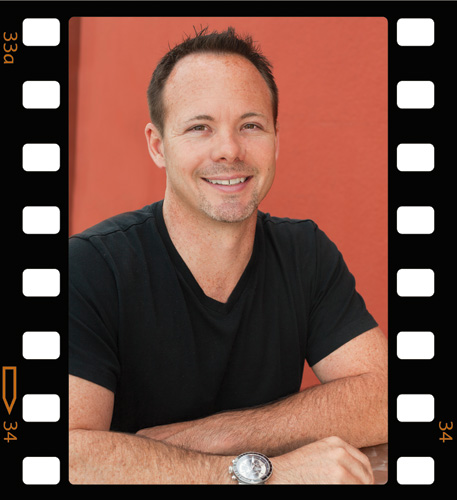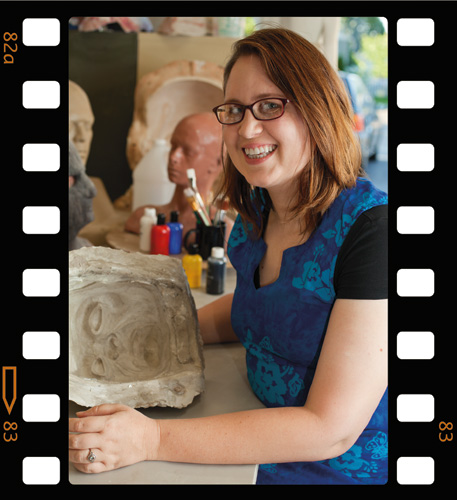Oregon’s homegrown film and TV businesses are getting savvier, growing up and going places.

Oregon’s relationship with the film and television industry has always run a bit hot and cold. In the 1980s, the state did a brisk business as a location for network movies of the week, but that trade eventually went away, a victim of sea changes in the broadcasting industry. A spate of made-in-Oregon movies — Stand by Me, Free Willy — helped support a film economy through the 1990s, then much of that business disappeared to Vancouver, B.C., now one of the major film-production centers in North America.
In 2012 the local industry is once again on a roll. Fueled by state incentives, the industry spent $130 million in Oregon in 2011 producing film, television and TV commercials, up from $62 million in 2009. Three television shows — Portlandia, Leverage and Grimm — are shooting in Oregon at the same time. Some might say the current flowering of activity, with the television series as Oregon’s product du jour, is just another example of the market’s historic ebbs and flows. And yet the signs also point to a new stage in the evolution of the local industry — a stage marked by a focus on homegrown productions and on the business, not just the art, of film and media production.
To be sure, Oregon has always been more than a back lot for L.A. studios. Laika, the Portland-based animation studio, released its second major film, ParaNorman, just last month, and Portland has long been an epicenter for independent filmmaking. And yet, a decade ago, most of those filmmakers were content making movies for the festival circuit that may or may not have been commercial successes. Today, the presence of Grimm and other Hollywood shows, not to mention the technological upheaval occurring across all media channels, is changing the paradigm.
“There’s been a real shift in focus,” says Harold Phillips, a local actor who writes the blog Oregon Film and TV Dollars. “I’m seeing a new credence in the local industry to the business of producing.” Still vulnerable to market ups and downs, Oregon is far from becoming a Hollywood North or a Vancouver South. “But something new is definitely going on,” says Tom McFadden, executive director of the Oregon Media Production Association (OMPA). “We’re at a tipping point, a watershed. People now understand that making money is within their grasp.”
There are definite signs of changing times in the film and new media industry: the Hollywood-fueled small-business boom; the new market-oriented independent filmmaker; the merging of the technology and creative storytelling sectors; and the push to get banks and investors to fund a sustainable, made-and-produced-in-Oregon ecosystem.
Collectively, these people, projects and initiatives point to a sprouting celluloid forest, as well as the challenges associated with making it grow.
Indie filmmakers grow up
 When he first started making movies 10 years ago, Todd Freeman, a Portland resident, was perfectly happy producing self-described art films for little or no money. Then one day, the 36-year-old son of a Baptist minister decided he wanted to be a little less of a starving auteur and more of a businessman. So in 2010 Freeman and his brother Jason shot three sci-fi horror films back to back. This past July, Cell Count, the third in the series, landed a worldwide distribution deal; the other two are in negotiations.
When he first started making movies 10 years ago, Todd Freeman, a Portland resident, was perfectly happy producing self-described art films for little or no money. Then one day, the 36-year-old son of a Baptist minister decided he wanted to be a little less of a starving auteur and more of a businessman. So in 2010 Freeman and his brother Jason shot three sci-fi horror films back to back. This past July, Cell Count, the third in the series, landed a worldwide distribution deal; the other two are in negotiations.
“We expect all three to be profitable,” says Freeman. The bigger the audience, the more you make money, he says. “And there’s a rabid group of sci-fi thriller fans out there hungry for original content.”
Emboldened by the Hollywood presence and eager to put down roots in a region renowned for its livability, Oregon filmmakers are taking an increasing interest in movies that might actually produce a return on investment — for themselves and the people they employ. That mindset is getting a boost from OMPA, which is currently on a mission to professionalize Oregon’s independent filmmaking hordes — “kids who make a feature for $6,000 get into a couple of film festivals, and expect everyone to work for free,” says Christopher Toyne, a local actor and OMPA board member.
Made for about $100,000 each, the Freeman brothers’ series, says Toyne approvingly, is the kind of project that can “up the game.” Leverage could be canceled; Grimm could be canceled, says Toyne, explaining why Oregon filmmakers need to target bigger- budget films. “We have to have a sustainable, locally grown industry at the same time as having the big shows.”
To make that happen, a growing number of filmmakers are modifying artistic principles and developing a laser focus on the market. Take Sean Skelding, owner of the aptly named Cheezy Flicks Productions, which operates out of an office in Portland’s eastside industrial district. A jovial 43-year-old with a John Candy vibe, Skelding sticks to an unabashedly low-class, B-movie formula, producing films like Stripperland and I Am Virgin with “lots of gore and a little T&A.” The key to his business model, says the Jefferson High graduate, is that he owns his own movie-distribution company, generating a steady income stream and helping guarantee an audience for the films he produces.
Declining to reveal gross revenues, Skelding claims he’s “very comfortable.” Plenty of people are making “wonderful, beautiful movies,” he says. “Are they making money? I don’t know.”
Portland actress Katie O’Grady recently starred in and produced what might be termed a wonderful, beautiful film, Rid of Me, a suburban satire directed by local James Westby and released last fall to widespread critical acclaim. “An ingenious black comedy,” observed The New York Times. Produced for about $107,000, Rid of Me is on its way to recouping its initial investment. But O’Grady, a mother of three who says she wants to shore up the Portland industry, is taking no chances. At work on a documentary about bullying, she’s now producing a horror film called The Basement. “I’m not going to lie to you. I’m in it to make money.”
Genre filmmaking isn’t the only game in town. In search of financial returns, local filmmakers are pursuing other pragmatic business models. Increasingly, they’re borrowing a page from big-studio marketing schemes, in which blockbusters such as Harry Potter spin off into graphic novels and games. The buzzword is “transmedia,” and one local example is Angel Punk, a project developed by Portland’s Relium Media.
A tale of a girl who discovers she is descended from angels, Angel Punk is being released as a young-adult novel, a movie, a graphic novel and a board game, says writer and producer Kevin Curry. The idea is to avoid the pitfalls associated with a stand-alone film that may or may not succeed at the box office — or on video. Instead, says Curry, Angel Punk’s transmedia approach spreads the risk and allows the producers to target different funders and markets depending on the platform. For example: “The book might lean young adult female, and the graphic novel and board game, male.”
That kind of marketing savvy is being touted at an ongoing series of OMPA-hosted film-financing seminars. The goal, says Toyne, who is moderating the series, is to encourage filmmakers to think more about how to fund, market and distribute their projects. Local filmmakers who have hit the big time, relatively speaking, are also preaching the business-planning gospel.
Freeman, for one, recalls the Portland of 10 years ago, when making movies was “more of a social-club mentality; you shot movies with friends.” A decade later, his Cell Count series is backed by two Oregon investors. It also is the first film project to qualify for Oregon’s indigenous film fund, which provides rebates for films produced by Oregonians who spend a minimum of $75,000 but not more than $750,000.
“It’s all progressing in a very positive way,” says Freeman.
Sean Skelding, owner of Cheezy Flicks |
//Photo by Sierra Breshears |
| A jovial 43-year-old with a John Candy vibe, Skelding sticks to an unabashedly low-class, B-movie formula with “lots of gore and a little T&A.” The key to his business model, says the Jefferson High graduate, is that he owns his own movie-distribution company. |
Making the case for investment
 A founder of Handyman Online, Eric Doebele, who splits his time between Seattle and Portland, has invested in numerous tech startups, including Cloudability, Paydici and SweetSpot Diabetes. But when Devon Lyon, Doebele’s old painting buddy, approached him about investing in the Angel Punk project — Lyon is writer and director — Doebele was, initially, less than enthusiastic. “Film financing is a very unique beast,” says Doebele.
A founder of Handyman Online, Eric Doebele, who splits his time between Seattle and Portland, has invested in numerous tech startups, including Cloudability, Paydici and SweetSpot Diabetes. But when Devon Lyon, Doebele’s old painting buddy, approached him about investing in the Angel Punk project — Lyon is writer and director — Doebele was, initially, less than enthusiastic. “Film financing is a very unique beast,” says Doebele.
Oregon has spent the past decade nurturing a software and tech ecosystem that includes angel investors willing to take a risk on high-tech startups. Today, as independent filmmakers become more entrepreneurial, industry insiders hope to grow their own pool of angel investors. It’s not an easy task. Portland may be moving up the professional ladder, but, says Todd Freeman, “a lot of PDX is still seen as a sort of art-film community” and not for serious investors “who look at it as profit.”
Finding Oregon-based investors is an even tougher job, says Angel Punk writer Kevin Curry, who is relying on leads from New York and L.A. to help raise about $2 million to jump-start the film portion of Angel Punk. “In Oregon, people aren’t used to that funding model.”
Investors aren’t the only private-sector nut to crack. To help fund a three-picture deal (Execution Point, Titanium Man and The Contract), Cheezy Flicks’ Sean Skelding approached three different Oregon banks for a loan. He was met with the equivalent of a blank stare. “In L.A. and New York, banks do this every day,” says Skelding, who secured financing for his next movie, Deal Breaker, from a Southern California institution. Oregon has great scenery and great talent, says Skelding. But pushing the industry to the next level — and keeping Oregon talent from decamping to L.A. — will require getting banks and investors onboard.
To help make that happen, OMPA is one of several entities tossing around the idea of creating a $100 million film fund, a public-private endeavor that would allow Oregon filmmakers to produce bigger, more profitable movies. Doebele has a more modest proposal: education and solid business planning. “If producers can figure out ways to structure the investment, protect equity investors from the downside risk, then explain it to them in a way that makes sense — that’s really important,” he says.
In the end, the Relium team did just that — separating out the funding stream for the film and transmedia elements and courting tech investors who might be attracted to the project’s multimedia sensibilities. Doebele, for one, was sold. So far he has invested $100,000 in the project. “It is a fantastic business model,” he says.
Eric Doebele, a founder of Handyman Online |
//Photo by Sierra Breshears |
| Doebele has invested in numerous tech startups, including Cloudability and Paydici. But when an old buddy approached him about investing in the Angel Punk project, Doebele was, initially, less than enthusiastic. “Film financing is a very unique beast,” he says. |
Small creatives making it
 Remember the Portlandia episode involving the bike messenger with grotesquely long earlobes about to be ripped asunder in the final scene? Those ears were the handiwork of Christina Kortum, a Portland special-effects makeup artist specializing in custom prosthetics. Among other items, Kortum has delivered a head for Leverage, wooden stakes and edible coins for Grimm, and a bone for the 2011 shot-in-Portland movie Gone. “She was supposed to use it to stab the bad guy,” says Kortum.
Remember the Portlandia episode involving the bike messenger with grotesquely long earlobes about to be ripped asunder in the final scene? Those ears were the handiwork of Christina Kortum, a Portland special-effects makeup artist specializing in custom prosthetics. Among other items, Kortum has delivered a head for Leverage, wooden stakes and edible coins for Grimm, and a bone for the 2011 shot-in-Portland movie Gone. “She was supposed to use it to stab the bad guy,” says Kortum.
A veteran of the haunted-house industry, Kortum credits the Oregon Production Investment Fund for boosting her career in film and television. Since 2005 the state has given cash rebates, capped at $6 million per year, to media production companies, which in turn create jobs and send business to local vendors. Kortum’s income, for example, has doubled each year because of the business generated by Portland’s Hollywood renaissance. “I went from doing a gig here and there to pretty much doing constant gigs that can support my family.”
A Leverage snapshot reveals the film fund’s larger quid pro quo. In the past four years, Leverage Productions has received $17 million from the incentive program. In return, the company has created about 2,800 production jobs, hired 7,000 extras and injected $100 million directly into the local economy. The long list of beneficiaries include 52nd Ave. Hardware, a Southeast Portland lumber and hardware shop that was ready to downsize after the economy crashed in 2008. After becoming the primary hardware vendor for Leverage and Grimm, the owners hired two additional employees — a 33% staff increase, says manager Dave Besaw. “For a small family busi-ness like us, the film industry is significant.”
Oregon’s film incentive has its critics, who argue the program unfairly benefits the wealthy. And despite the ripple effects, even the most ardent boosters concede incentives alone aren’t enough to sustain a local film economy. Portland has gone from being a low-budget town to a place where “big things happen,” says Kortum.
But what Hollywood gives, she acknowledges, it can taketh away. “The film industry — it’s like the locust. They come in, set up and everyone is rolling in money. Then they leave and it’s like:
What else?”
Christina Kortum, special-effects artist |
// Photo by Sierra Breshears |
| Kortum has delivered a head for Leverage, wooden stakes and edible coins for Grimm, and a bone for the 2011 shot-in-Portland movie Gone. A veteran of the haunted-house industry, Kortum credits the Oregon Production Investment Fund for boosting her career in film and television. |
Storytelling meets technology
 Digital technologies have already turned traditional entertainment business models upside down, paving the way for the Netflix and YouTubes of the world. In Oregon, already a mecca for animation, games design and digital media, a few pioneers are now starting to think about the next phase of the digital entertainment revolution: how new technologies will actually change the nature of storytelling itself, and how Oregon might position itself to capture this “next generation” storytelling market.
Digital technologies have already turned traditional entertainment business models upside down, paving the way for the Netflix and YouTubes of the world. In Oregon, already a mecca for animation, games design and digital media, a few pioneers are now starting to think about the next phase of the digital entertainment revolution: how new technologies will actually change the nature of storytelling itself, and how Oregon might position itself to capture this “next generation” storytelling market.
The innovators include Scotty Iseri, a Portland web-series creator who is developing The Digits, a math-education web series for kids that includes episodes formatted for mobile apps and tablets, as well as online YouTube episodes. As Iseri describes it, the storytelling novelty behind The Digits, which follows live-action characters who travel the galaxy fighting evil, is that it combines interactive game-design elements with a linear narrative.
In film and television, digital media is typically used for “secondary marketing content,” says Iseri, citing as an example alternate reality games meant to market a film.
The Digits, by contrast, actually allows the viewer to control the outcome of the story. “The asteroids the kids see hurtling through space need to be blasted in half,” he says. “This is the math lesson, but depending on how they split it, it also controls the outcome of the story in the app.” The Digits was the first next-generation media project to receive rebates from the indigenous film fund. Iseri has also raised $500,000 from family and investors.
As Iseri suggests, marketing gurus are driving much of the innovation in digital storytelling, from Wieden+Kennedy — which famously leveraged Twitter, Facebook and blogs to produce more than 100 YouTube videos about Old Spice — to boutique agencies such as Portland’s Instrument, which started out as a web-development firm but has since made a name for itself delivering creative digital content. But tech companies such as Elemental Technologies, a Portland company pioneering new ways for media companies to deliver content on mobile devices, may also play more of a role.
Today film, television and digital media are “all headed in the same direction,” says Vince Porter, executive director of the Oregon Governor’s Office of Film & Television. “They all fall under a giant umbrella of content developers.” For Porter, those commonalities, as well as Oregon’s strength in creative and tech sectors, lead to an obvious question: Why not bring all the stakeholders together to help make the state a leader in the next-generation arena?
As a step in that direction, this past spring the film office partnered with Intel Labs and the Portland Incubator Experiment on a “Future of Storytelling” hackathon, bringing together creative professionals representing film, television, video games, web, interactive and digital media.
Exactly how this kind of collaboration will seed new projects or companies is not clear. But such cross-pollination is not new. Oregon has a history of mixing old and new forms of narrative — Laika, for example, is known for bringing stop-motion animation, a classic storytelling form, into the modern world of computer technology. Oregon creatives are building on that hybrid heritage to try and create a more sustainable media ecosystem, one that boosts the fortunes of old-school independent filmmakers as well as digital innovators.
Oregon “is an unusual combination of urban center and frontier watering hole,” says Laika CEO Travis Knight, who recently announced an increase in output of his own: The animation studio is positioning itself to release a new film every year.
“Anytime you have that kind of heterogeneity, you have fertile ground for creativity. The more people become aware of what’s happening here, the more the industry will grow.”
Scotty Iseri, web-series creator |
//Photo by Sierra Breshears |
Iseri is developing The Digits, a math-education web series for kids that includes episodes formatted for mobile apps and tablets, as well as online YouTube episodes. The Digits was the first next-generation media project to receive rebates from Oregon’s film fund. |
Linda Baker is the managing editor of Oregon Business. She can be reached at [email protected].






